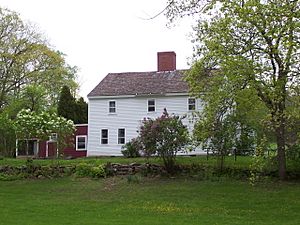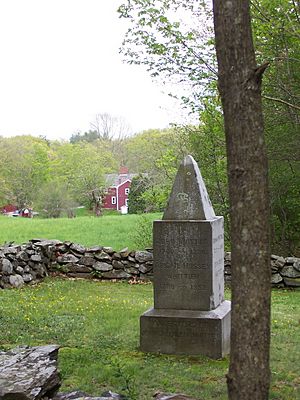John Greenleaf Whittier Homestead facts for kids
The John Greenleaf Whittier Homestead is a special house in Haverhill, Massachusetts. It's where a famous American poet named John Greenleaf Whittier was born and grew up. He was also a Quaker, which is a type of Christian, and worked to end slavery. Today, this old house is a museum you can visit. It is located at 305 Whittier Road in Haverhill, Massachusetts.
Contents
The History of Whittier's Home
This historic home was built way back in 1688. It was built by Thomas Whittier, who was John Greenleaf Whittier's great-great-grandfather. Thomas picked this spot because it was close to Fernside Brook. The brook provided water and could power a gristmill, which grinds grain.
John Greenleaf Whittier was born in this farmhouse in December 1807. He was born in the southwest parlor, and that room still looks much the same today. Growing up, John worked hard on the farm. He often had headaches and felt tired from all the work. He didn't go to Quaker meetings or school very often. He also found out he was color-blind when he couldn't tell ripe strawberries from unripe ones.
How Whittier Became a Writer
Whittier loved to read, thanks to his family's small library. He especially enjoyed the poems of Robert Burns. His sister, Elizabeth, and his mother, Abigail, really encouraged his interest in writing. However, his father, John, thought farm work was more important than school or writing.
Whittier's first poem was called "The Exile's Departure." It was printed in the Free Press newspaper in Newburyport, Massachusetts on June 18, 1826. The editor, William Lloyd Garrison, helped young Whittier go to Haverhill Academy. The family paid for his schooling with food grown on their farm. For a short time, Whittier even worked as an editor for the Haverhill Gazette newspaper.
Whittier lived in this home for 29 years. In 1836, he moved to Amesbury, Massachusetts and sold the family farm. The house he moved to in Amesbury, called the John Greenleaf Whittier House, is also open to visitors.
The Famous Poem Snow-Bound
The homestead is the setting for Whittier's most famous poem, Snow-Bound. This long poem was published in 1866 and quickly became a bestseller. Whittier also wrote other poems about the Haverhill area. These include "Fernside Brook," "The Barefoot Boy," and "The Sycamores."
Because Snow-Bound was so popular, the home became famous too. People loved the poem's cozy description of the kitchen. They even wanted to make their own kitchens look like Whittier's childhood hearth. In 1881, Whittier noted that someone from Cleveland, Ohio asked for the exact size of his Haverhill kitchen. They wanted to copy it! Whittier wrote that he never imagined his poem would be so popular.
The Homestead After Whittier
After John Greenleaf Whittier passed away in 1892, his childhood friend, James Carleton, bought the farm. Carleton had been a mayor of Haverhill. He gave the property to the Haverhill Whittier Club. The home officially opened as a museum in 1893, just one year after the poet's death.
Today, it's a hands-on museum. Visitors can sit in chairs that the Whittier family actually used. The guest book for visitors sits on a desk built in 1786 for Whittier's great-grandfather. The family burial plot is also on the grounds of the Homestead. However, Whittier himself is buried in Amesbury.
The home became a museum during a time when people loved old American history. This was called the Colonial Revival Movement. Whittier's home was one of the first houses of writers to be restored for tourism. Books by people like Alice Morse Earle often showed old-fashioned New England life. Earle even put a photo of Whittier's fireplace in her book Home Life in Colonial Days. She often quoted Snow-Bound in her writings.
See also




